Bees are a common sight in our day-to-day lives. We see them buzzing around gardens and yards as we pass by. And while some pay them no mind, others avoid these creatures like the plague. Bees possess stingers for defense. But they don’t typically use them unless they are aggravated or accidentally stepped on. However, if you’ve ever come across a hive during a muggy summer, you know that it doesn’t take much to aggravate bees. Many people have been stung at least once in their life, and it’s not typically an experience you want to repeat. But you may be curious to know which species have the most unpleasant stinger. Discover 11 bees found in Georgia, ranked by most painful sting using the Schmidt sting pain index.
This index is a pain scale, ranging from level zero to four, with four being the most painful of insect stings. Level zero includes stings that are ineffectual against humans. Level one is mildly painful, level two is moderately painful, level three is highly painful, and level four is the most painful.
1. Carpenter Bee (level 2)
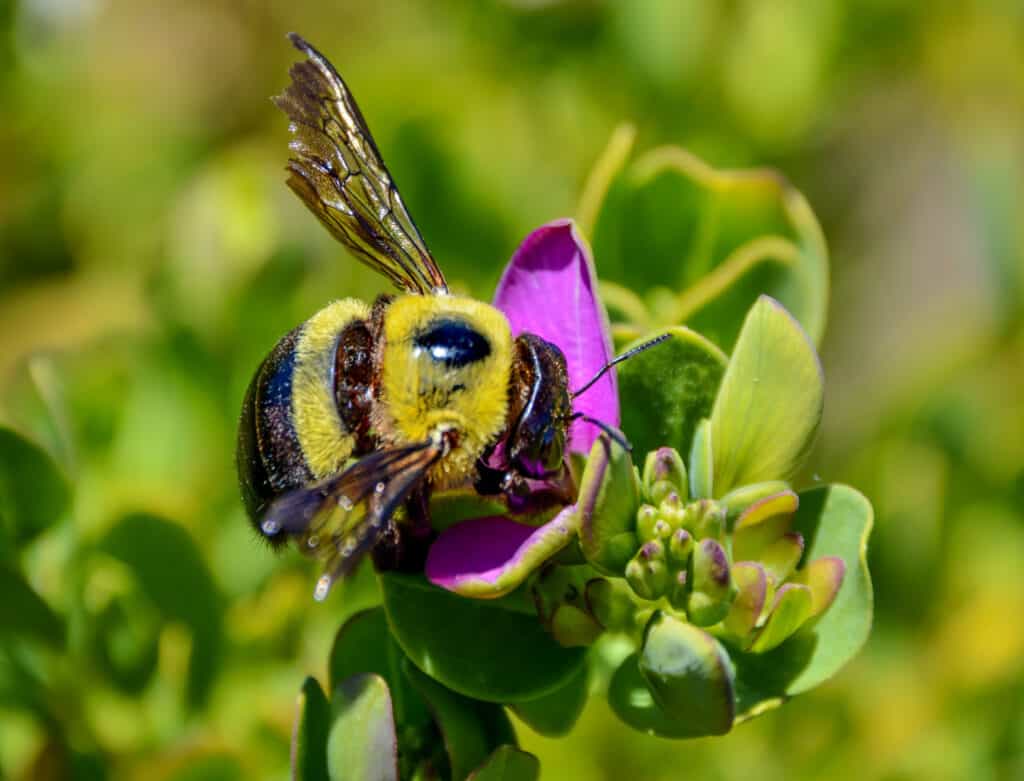
Carpenter bees have shiny hairless abdomens and a thick, robust appearance.
©Cathy Withers-Clarke/Shutterstock.com
Description: Carpenter bees are very large bees, measuring 14 to 19 mm. They have black bodies with thick yellow hair on their head and thorax. These bees also have shiny hairless abdomens and a thick, robust appearance. They are not afraid of humans.
Habitat: You will most often find this species near dead, dry trees. But they also nest in residential areas, such as homes with wooden structures, wooden fences, and decks.
Prevalence and Emergence: Carpenter bees are common in Georgia, where they are most prevalent between March and October. They are typically one of the first species that emerge in the spring.
Pain Level: This species can sting more than once, causing moderate sharp pain and a burning sensation. The sting can leave a swollen red welt that lasts for several days.
2. Honeybee (Level 2)
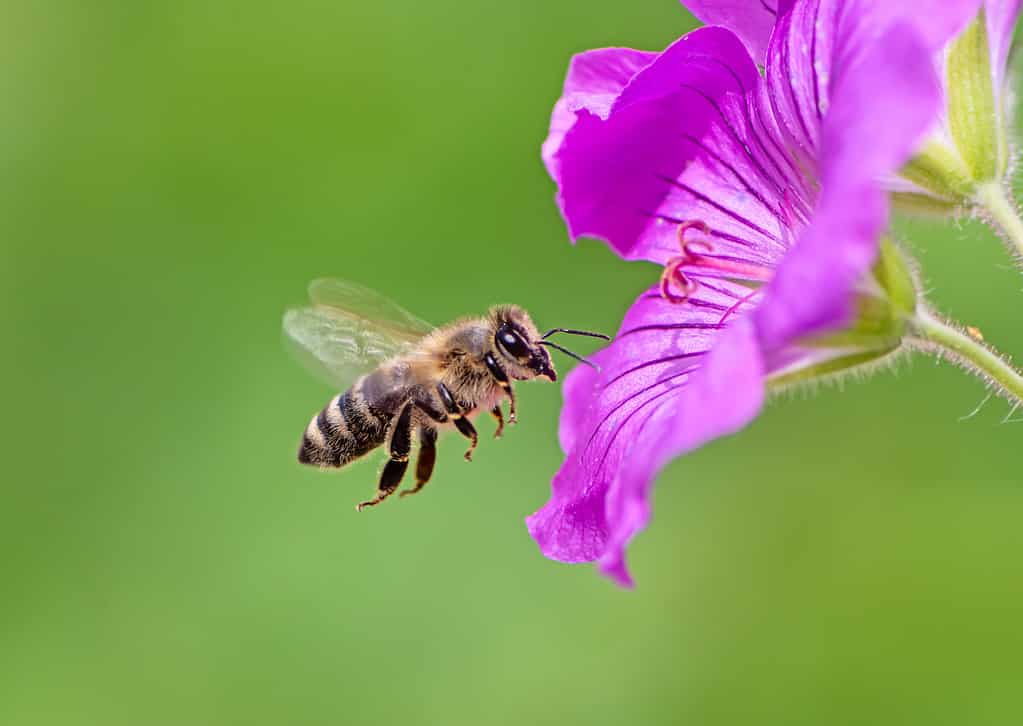
Honeybee stings are instant and sharp, leaving a burning sensation and red welt that can last a few days.
©iStock.com/manfredxy
Description: The average honeybee is slightly smaller than the carpenter bee, measuring 12 to 15 mm. However, queens can reach up to 22 mm. Their coloring is golden brown with black stripes. And they are known for their slow flight and fearlessness around humans.
Habitat: You are likely to spot honeybees in abundant flowering areas, such as gardens, orchards, and meadows.
Prevalence and Emergence: This species is abundant in the state where they live year-round. It is one of the most common types of bees in Georgia.
Pain Level: Similar to the carpenter bee, honeybees cause moderate pain. Their stings are instant and sharp, leaving a burning sensation and red welt that can last a few days.
3. Horned Bees (Level 2)

Horned bees are not known for being aggressive.
©Claire Anna Jones/Shutterstock.com
Description: They range in size from medium to very large, measuring between 9 and 20 mm, depending on the species. Georgia has long-horned bees, sun-flower bees, and Alfalfa long-horned bees. They are light brown to black, with white hair covering their heads and thoraces.
Habitat: You are most likely to spot a horned bee near grasslands and woodland clearings.
Prevalence and Emergence: Horned bees are uncommon in Georgia. But they are most abundant from May through October.
Pain Level: While their stings can be moderately painful, horned bees are not aggressive. Their stings leave sharp, burning welts like other bees.
4. Bumblebee (Level 2)
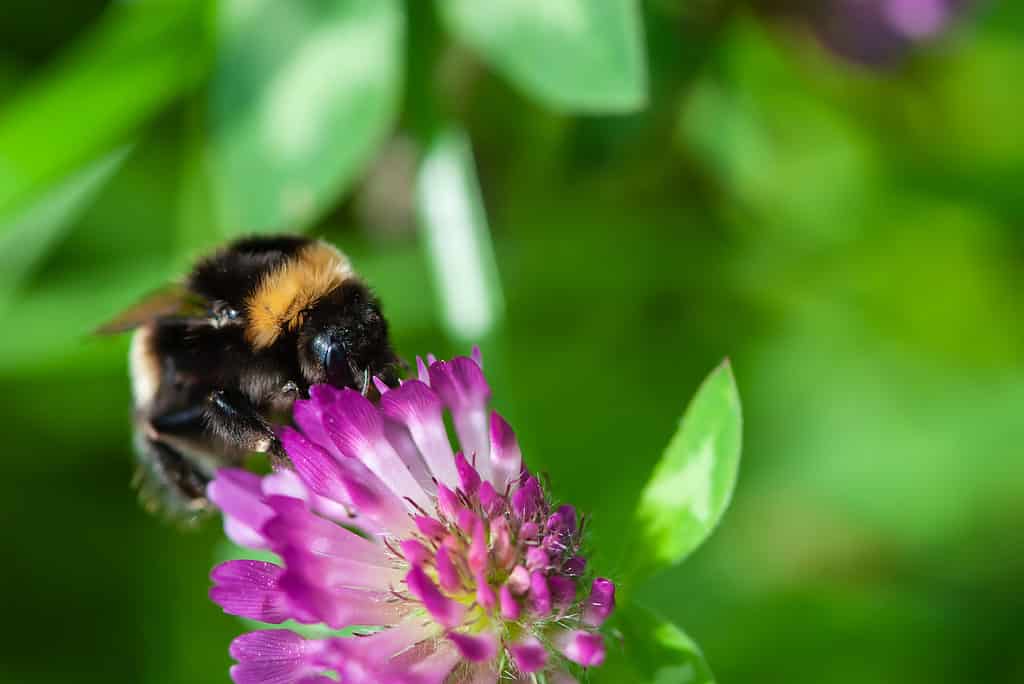
The
bumblebee
is a common species in Georgia.
©iStock.com/Tanja Nik
Description: Bumblebees are very large, measuring 10 to 25 mm. They have black bodies and yellow and black hair. These bees appear round and plump, with small heads. They are one of the biggest types of bees in Georgia.
Habitat: You can find them anywhere flowering plants are abundant, including meadows, gardens, orchards, and backyards.
Prevalence and Emergence: Bumblebees are common in Georgia. They are one of the first species to emerge in the spring, lasting from March to October.
Pain Level: While bumblebee stings are not as painful as other insects, like hawk wasps, their stingers leave painful and swollen welts. Many describe bumblebee stings as mild to moderately painful.
5. Mason Bee (Level 2)
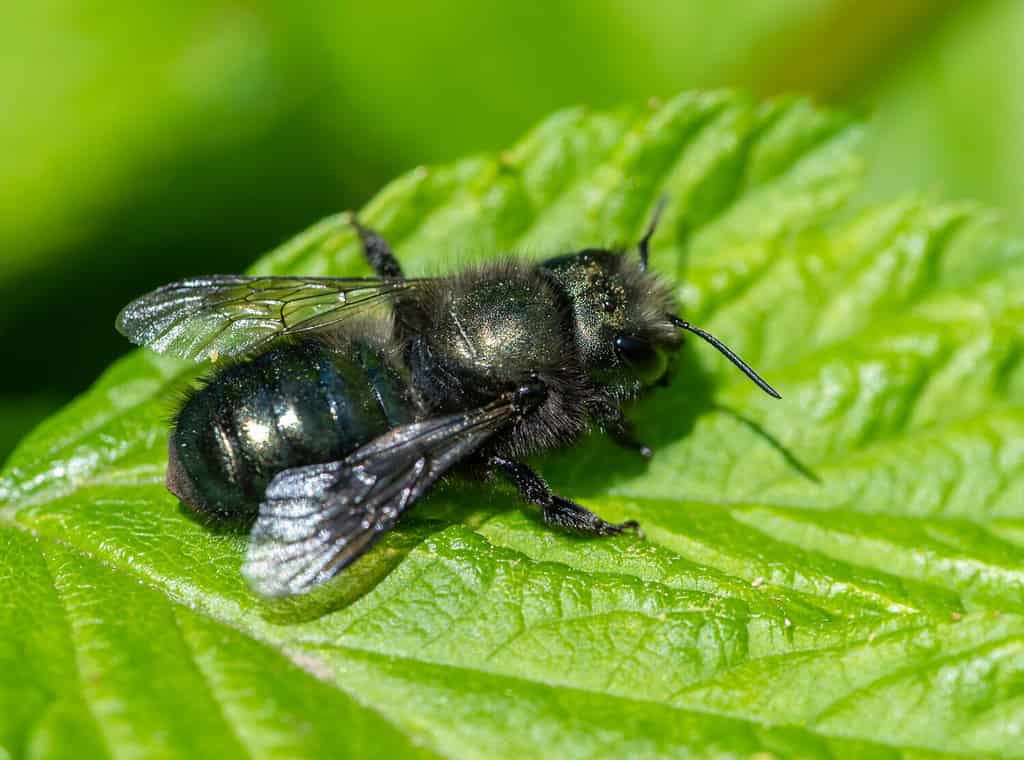
The mason bee features metallic black, green, and blue coloring.
©Jennifer Bosvert/Shutterstock.com
Description: With most measuring between 6 and 12 mm, mason bees are small to medium-sized. They are somewhat easier to identify due to their metallic black, green, and blue coloring. And they are very fast flyers, often zipping around early flowering plants.
Habitat: Mason bees prefer habitats such as shrublands and deciduous forests.
Prevalence and Emergence: This species is not common in Georgia. You are more likely to see them very early in spring, from February to May.
Pain Level: This is another mild to moderate sting, leaving a sharp pinch and burning sensation.
6. Leaf-Cutter Bees (Level 1)
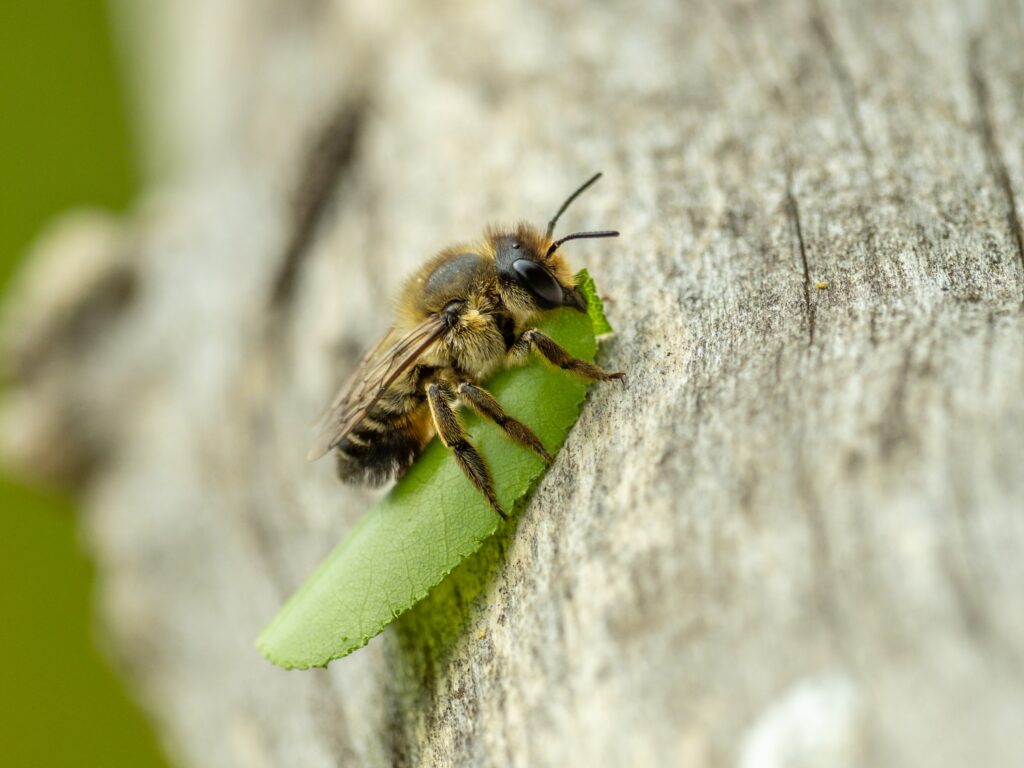
Leaf-cutter bees are solitary and non-aggressive.
©Keith Hider/Shutterstock.com
Description: Leaf-cutters are medium to large bees, measuring eight to 15 mm. They feature black bodies with white hairs covering most of their thoraces and abdomens. These bees also possess large heads and scissor-like jaws.
Habitat: You can find them in most areas with flowering plants. But they make their nests in cavities, lining them with leaves.
Prevalence and Emergence: These bees are common in Georgia during spring, but you can find them in the state from May to October.
Pain Level: Leaf-cutter bees are solitary and non-aggressive. They occasionally sting people, but the pain is very mild, much less than honeybees or the like.
7. Sweat Bees (Level 0.5)

The sweat bee is typically very small, measuring only a few millimeters.
©Barbara Storms/Shutterstock.com
Description: There are several species of sweat bees in Georgia, and they range from very small (3.5 mm) to medium (11 mm). Most are metallic blue or green, with striped abdomens.
Habitat: You will find them where flowers are abundant, such as roadsides, gardens, fields, and grasslands.
Prevalence and Emergence: Sweat bees are very common in Georgia, but you often won’t notice them due to their small size. And you can find them from late February to November.
Pain Level: These small bees have light stings, either registering a mild sting to barely noticeable.
8. Mining Bees (Level 0.5)

Most mining bees that you come across will be males, which don’t possess stingers.
©Gabi Wolf/Shutterstock.com
Description: Mining bees are small to large, measuring four to 17 mm. They are black with various colored hair, ranging from white, brown, and yellow. And they can either be hairless or very hairy.
Habitat: These bees are solitary ground nesters. They live near hills, riverbanks, and old buildings.
Prevalence and Emergence: Mining bees are extremely abundant in Georgia during the spring but begin to decrease as the summer progresses. Look for them from March to May.
Pain Level: This species is solitary and non-aggressive, so it would be very rare to be stung by one. And most that you come across will be males, which don’t possess stingers. Further, their stingers are small and barely penetrate human skin.
9. Cuckoo Bees (Level 0.5)
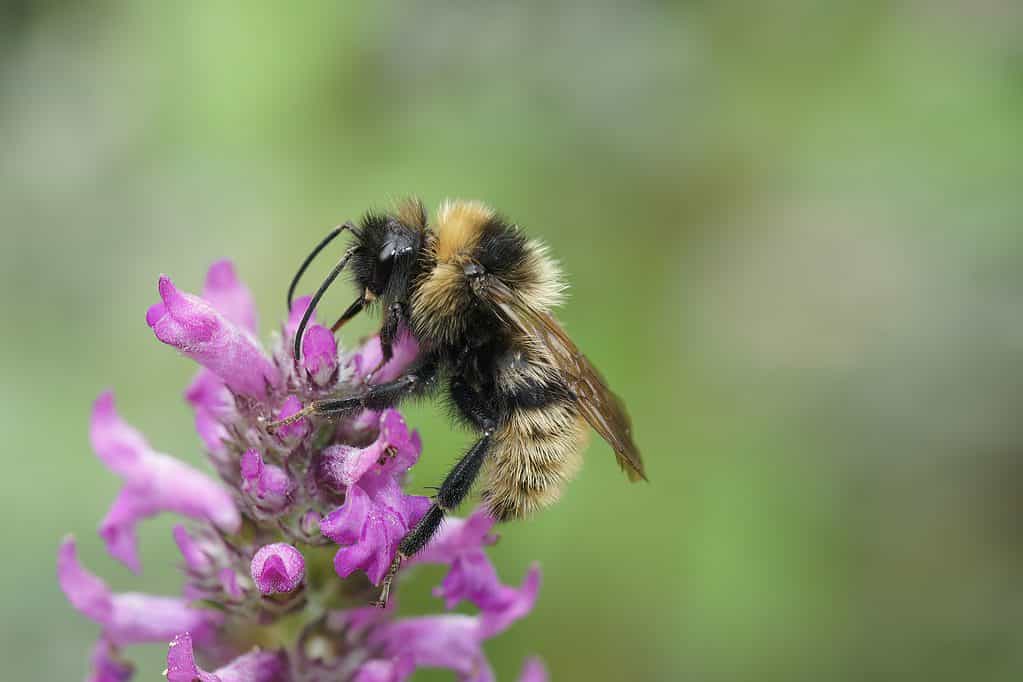
Cuckoo bees parasitize the nests of other bees.
©HWall/Shutterstock.com
Description: Cuckoo bees range from medium to large, averaging between seven and 14 mm. They are another easy-to-identify bee featuring bright yellow or red coloring. Some have vibrantly colored exoskeletons, while others possess bright fuzz. These bees are known for their hovering flight.
Habitat: They parasitize the nests of other bees, so they can be found in many habitats, from woodlands to urban areas.
Prevalence and Emergence: Depending on the species, cuckoo bees are common to uncommon in Georgia. But you can find them from March to October.
Pain Level: These bees are not particularly known for stinging humans. But even when they sting, you most likely wouldn’t notice. The cuckoo bee sting doesn’t even register as mild.
10. Blueberry Bees (Level 0.5)

Blueberry bees are prevalent in Georgia from March to June.
©Erik Karits/Shutterstock.com
Description: Measuring 12 to 15 mm, blueberry bees are large. They look similar to bumblebees, but their abdomens are hairless. They also fly like bumblebees. However, they are somewhat fearful of humans.
Habitat: They nest in the ground in open areas that get plenty of sun. You are likely to see them in fields and farmland. They are also prevalent in blueberry orchards.
Prevalence and Emergence: This bee is relatively uncommon in Georgia. They are more prevalent in the state between March and June.
Pain Level: This species is not aggressive, and they live solitary lives. It is very unlikely that you would be stung by a blueberry bee. But even if you accidentally step on one and it uses its stinger in defense, the pain would be very mild.
11. Squash Bees (No Pain)
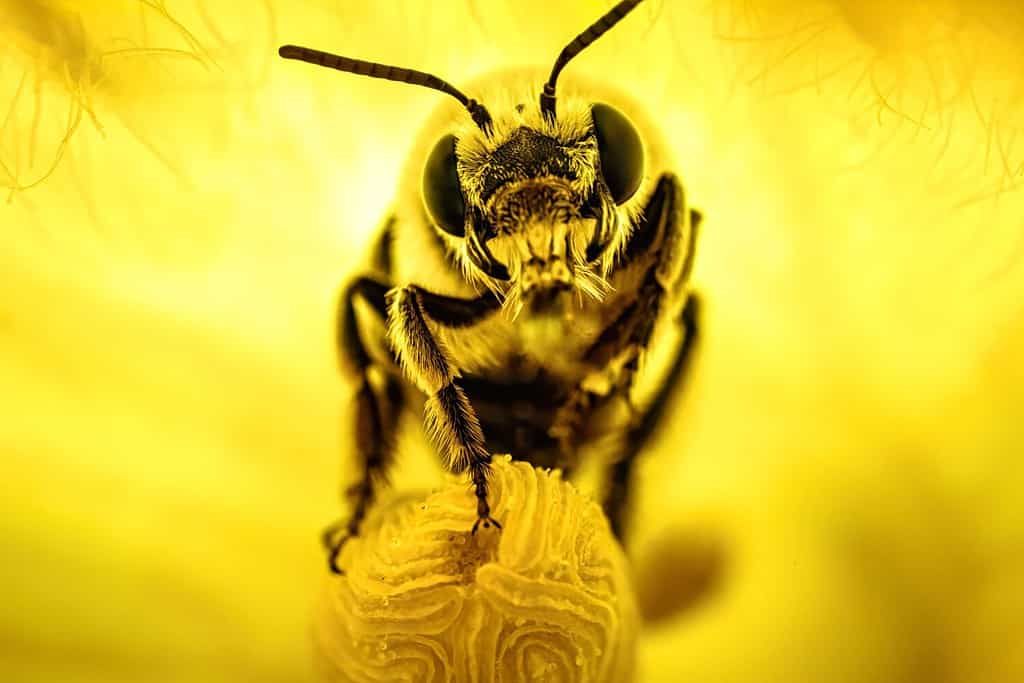
Squash bees have a matinal activity cycle, meaning they fly before sunrise when the cucurbit flowers are open.
©Joseph Burdick/Shutterstock.com
Description: The squash bee is large to very large, measuring 12 to 18 mm. Their heads are black and yellow or white. And their bodies are black with abdominal stripes.
Habitat: You will find these bees wherever squashes are grown, where they fly around during the early morning.
Prevalence and Emergence: Squash bees are common in Georgia from late April to late November.
Pain Level: This species poses no threat because the males do not possess stingers. And the females are docile and don’t like using their stingers.
The photo featured at the top of this post is © HWall/Shutterstock.com
Thank you for reading! Have some feedback for us? Contact the AZ Animals editorial team.







